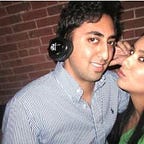Using your best work to advance your career
A simple framework for business folk & knowledge workers craving something deeper than a resume
Through Mural, I get a chance to meet a lot of unique talent and see the different ways in which they present their best work & professional stories. It’s super fun — especially because our users tend to care deeply about their work and excel in fields that traditionally don’t build professional portfolios (e.g. product management, copywriting, marketing). But they are starting to see the merits of doing so.
I’ve started to notice some common themes among folks whose Murals (read: non-traditional portfolios) do a particularly good job of demonstrating their skills and sharing their professional stories, so I tried to summarize a few of those themes below. Hope you find them helpful and look forward to any additional you thoughts you might have!
A simple framework for building effective professional portfolios
In general, great professional portfolios, especially those targeted toward potential clients & employers, communicate three key attributes:
- value (outcomes your work has driven)
- repeatability (how you did it and could do it again)
- transferability (how it applies to what you might want to do next)
Value
“Be clear about the outcomes your work helped drive and the business/social/organizational goals it advanced.”
When building your portfolio, it’s often easy to prioritize proof (“I did/created this”) over perspective (“why I did it and what it means”). This is often a mistake, especially for most knowledge workers, whose work products — specs, decks, spreadsheets, and even blog posts — are often not easily evaluated at face value (unlike a design, photograph or even software product).
As such, it’s important be explicit about the outcomes your work helped drive and the business/social/organizational goals it advanced. Objective and third party evaluations like quantitative metrics, user testimonials, and ratings/reviews are your best friends here.
Click for examples: Benjamin Jackson (product), Alexander Spoor (marketing) and Cecilia Copeland (screenwriting).
Repeatability
“Demonstrate that your best work can, and will, happen again.”
Almost as important as being explicit about the outcomes you have helped drive is being clear and concise about how you did it, and what you learned in the process. Demonstrate that your best work can, and will, happen again — with examples, methods, templates and learnings.
In general, your goal here is to “lift the hood’ as much as possible to enable people interested in working with you to understand what it’s like to do so — by sharing exemplar assets of your best work. Examples include specs/roadmaps, analysis/spreadsheets/models, internal/external decks and the like. If you have concerns around confidentiality, quickly creating templates from such assets or anything else that is a routine part of your job is often the easiest way to lift the hood on how you approach your work without risking sensitive details of clients/employers.
Other effective alternatives include summaries of your methods/perspectives you may have prepared for clients, employees & other collaborators, as well as blog posts/tweetstorms/podcasts about your learnings & best practices.
Click for examples: Ajay Rajani (me), Mike Taylor (instructional designer), Lateisha Moore (product/design), Lewis Kang’ethe Ngugi (UX/UI) and Greg Docter (sales/ops).
Transferability
“In a rapidly changing (and automating) world, it’s imperative to demonstrate curiosity, an experimental mindset and first principles thinking.”
In a rapidly changing (and automating) world, companies are in perpetual discovery mode as they seek new markets, experiment with new technologies and consider new models for human capital deployment. As such, it’s imperative for knowledge workers and creative professionals alike to demonstrate curiosity, an experimental mindset and first principles thinking.
Although not conventionally included in formal resumes, things like side projects and outside-of-work learning (e.g. Coursera or Skillshare classes on subjects outside of your core competency) are often the most sincere and effective ways to demonstrate curiosity. You can also look to share your interest in / research around new platforms/mediums (e.g. blockchain/crypto, VR/AR) and markets (e.g. emerging markets and e-sports).
Finally, communicating to potential clients/employers a habit of experimentation is an incredibly powerful tool in today’s innovation economy. Things like Kickstarters or ProductHunt launches you contributed to as as well as idea backlogs, experimental design docs, hypothesis statements, lab reports (any way to distill learnings) and post-mortems are all helpful assets here.
Click for examples: Shaun Manning (writing), Philip Kalberg (entrepreneur), Britt Whidden (marketing), Fabrizio Boscaglia (academic researcher) and James Dietz (physics student).
Simple tactical tips
In addition to the substantive themes highlighted above, there are two simple tactical things you can do maximize the impact of your portfolio.
- Routinely update it with your latest work, experiments and learnings to demonstrate momentum, versatility, and consistency.
- Actively curate sub-portfolios for specific audiences to maximize ‘fit’ and get to the important stuff as fast as possible :)
For what it’s worth, these are two things that Mural make really easy :)
That’s all for now.
If you have any other tips, ideas, or best practices for product managers to build their identity and reputation, I’d love to hear them! You can find me on Twitter, email (ajay@corelabs.xyz) and in the comments.
What is Mural?
Mural is the fastest and easiest way for people to share their best work and professional story. It was born out of the frustration of trying to communicate the work that we do inside the constraints of a traditional resume or Linkedin Profile. We believe everyone (not just designers and/or engineers) should have the opportunity to easily create and share beautiful portfolios of their work, and look forward to seeing yours soon!
